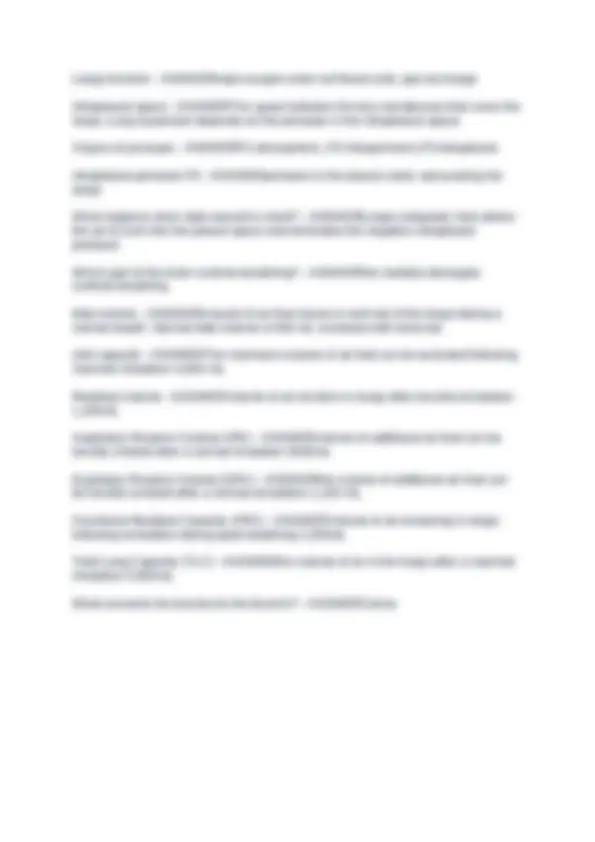



Study with the several resources on Docsity

Earn points by helping other students or get them with a premium plan


Prepare for your exams
Study with the several resources on Docsity

Earn points to download
Earn points by helping other students or get them with a premium plan
Community
Ask the community for help and clear up your study doubts
Discover the best universities in your country according to Docsity users
Free resources
Download our free guides on studying techniques, anxiety management strategies, and thesis advice from Docsity tutors
respiratory system - ANSWERComprises the upper and lower respiratory tract, delivers rich oxygen to the body and excretes carbon dioxide from the body. Filters and humidifies inhaled air, regulates acid base balance, produces sound (voice), houses olfactory (smell) chemoreceptors Bronchitis - ANSWERinflammation of the bronchi Emphysema - ANSWERA serious disease that destroys lung tissue and causes breathing difficulties.
Typology: Exams
1 / 3

This page cannot be seen from the preview
Don't miss anything!


respiratory system - ANSWERComprises the upper and lower respiratory tract, delivers rich oxygen to the body and excretes carbon dioxide from the body. Filters and humidifies inhaled air, regulates acid base balance, produces sound (voice), houses olfactory (smell) chemoreceptors Bronchitis - ANSWERinflammation of the bronchi Emphysema - ANSWERA serious disease that destroys lung tissue and causes breathing difficulties. bronchial tree - ANSWERthe branching system of bronchi and bronchioles conducting air from the windpipe into the lungs. Consists of bronchi, bronchioles, alveoli. Resembles a upside down tree. Trachea divides in two brinchi left and right. Left bronchi is narrower and positioned more horizontally than the right bronchus. upper respiratory tract - ANSWEROutside chest cavity; nose, nasal cavities, pharynx, larynx, and upper trachea lower respiratory tract - ANSWERlower trachea, bronchi, bronchioles, alveoli Trachea - ANSWERThe windpipe; a passage through which air moves in the respiratory system. I inch diameter extends from larynx down to thoracic cavity where it splits into right and left bronchi thyroid cartilage - ANSWERAdam's apple, anterior cartilage that covers the larynx Lung expansion depends on what to expand? - ANSWERDepends on the pressure within the intrapleural space What are the two reasons why lungs collapse? - ANSWERelastic recoil and surface tension elastic recoil - ANSWERLungs can stretch but recoils and returns to its unstretched position if tension is released. (Think of balloon) surface tension - ANSWEREletrical attraction of the water molecule is surface tension; tend to collapse the alveoli Surfactants - ANSWERAllows the alveoli to expand and deflate; detergent like COPD (chronic obstructive pulmonary disease) - ANSWERA group of lung diseases that block airflow and make it difficult to breathe. Asthma, bronchitis, emphysema
Asthma - ANSWERA chronic allergic disorder characterized by episodes of severe breathing difficulty, coughing, and wheezing. Alveoli - ANSWERFunction is to exchange oxygen and carbon dioxide across the alveolar pulmonary capillary membrane, grape like structure Bronchioles - ANSWERRegulate the flow of air to the alveoli; divide repeatedly into smaller tubes. Bronchi - ANSWERtwo short branches located at the lower end of the trachea that carry air into the lungs. How many lobes in the lungs? - ANSWER5 lung lobes; right lung has 3 and left lung has 2 Epiglottis - ANSWERLocated at the top of larynx; acts as a flap and covers the trachea during swallowing so food doesn't enter the lungs atelectasis - ANSWERCollapse of alveoli, preventing the normal respiratory exchange of oxygen and carbon dioxide. Happens in pneumonia and cancer in lungs apex of the lung - ANSWERuppermost portion of the lung base of the lung - ANSWERlower portion of the lung parts of the pharynx - ANSWERnasopharynx, oropharynx, laryngopharynx nasopharynx - ANSWERupper portion of the pharynx oropharynx - ANSWERmiddle portion of the pharynx laryngopharynx - ANSWERthe lower part of the pharynx oxygen and carbon dioxide - ANSWERTwo gases exchanged in the lungs (alveoli) Sx of acute asthma exacerbations - ANSWER-only able to say a few words with each breath -severe SOB -sx unresponsive to usual RX (inhaled SABA) pneumothorax - ANSWERair in the pleural cavity caused by a puncture of the lung or chest wall hypoxeia - ANSWERNot enough oxygen, bluish skin color pleural effusion - ANSWERabnormal accumulation of fluid in the pleural space atelectasis - ANSWERcollapse of alveoli